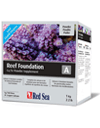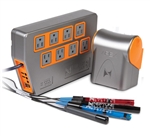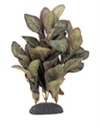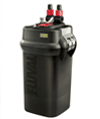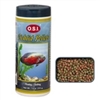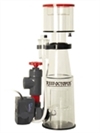How to Keep Clownfish and Anemones

If you know the name of any saltwater fish, it is a clownfish. Nearly all saltwater aquarists keep clownfish at some time, and for many keeping clownfish with an anemone is why they entered the hobby. Did you know that there are 26 species of clownfish with multiple color morphs within each species? Do you know their diet, their social structure, and their natural anemone hosts? What fish are clownfish compatible with? Can you mix species and color morphs of clownfish? This is the place to find your answers.
Types and Species of Clownfish
There are 26 species of clown fish but not all of these are in the aquarium hobby, and some are very rare. There are 10 of species commonly found in the aquarium hobby that we will discuss. Each species of clownfish will reach a different size and has a different temperament. There are also various subspecies or color morphs within some of the species. Subspecies are the same animal with the same temperament and care but they occur in a different color variation.
- (Common Clownfish/Nemo) Amphiprion Ocellaris
- Morphs
- Onyx Clown
- Mocha Clown
- Wyoming White Clown
- Platinum Clown
- Storm Clown
- Black and White Clown
- (Percula Clownfish) Amphiprion Percula
- Morphs
- Picasso Clown
- True Percula Clown
- Misbar Clown
- (Maroon Clownfish) Permnas Biaculeatus
- Morphs
- Gold Stripe Maroon Clownfish
- Lighting Maroon Clownfish
- Gold Nugget Clownfish
- (Tomato Clownfish) Amphiprion Fernatus
- (Cinnamon Clownfish) Amphiprion Melanopus
- (Pink Skunk Clownfish) Amphiprion Peirderaion
- (Orange Skunk Clownfish) Amphiprion Sandaracinos
- (Saddleback Clownfish) Amphiprion Polymnus
- (Clarkii Clownfish) Amphiprion Clarkii
- (Seabae Clownfish) Amphiprion Seabae
Clownfish do not have any special water parameter requirements, but you should aim to maintain the recommended values for marine aquariums. Our recommended values are below.
Clownfish Water Parameters
|
Saltwater Aquarium Parameters
|
|
Temperature
|
77-81
|
|
Ammonia
|
0 ppm
|
|
Nitrite
|
0 ppm
|
|
Nitrate
|
30 ppm
|
|
Phosphate
|
1 ppm
|
|
Alkalinity
|
8-10 dKH
|
|
pH
|
7.8-8.4
|
|
Salinity
|
1.024-1.026 Specific Gravity
|
Clownfish Diet
Clownfish are omnivores—they will eat both meat and algae-based foods. Most clownfish species are small and will accept smaller particle-sized foods. Small to medium-sized pellet foods, flake foods, and small frozen items like mysis shrimp and brine shrimp are all great food options. Clownfish should be feed daily.
Antaxanthin is a color enhancer included in many specialized clownfish foods because it helps to enhance the bright orange color of the fish. If you really want the brightest clownfish, you will want to use a food with Antaxanthin.
New Life Spectrum Marine Fish and
New Life Spectrum Thera+A food formulas both contain Antaxanthin and other natural color enhancers.
Clownfish Social Structure
In nature, clownfish live in harems with one dominant female fish and multiple smaller male fish. All clownfish are born male and the dominant fish will change into a female. The female fish will then produce hormones that stop the other fish from changing to female.
With this in mind there are a few things to note. We would never recommend mixing clownfish species. This will almost always result in one species killing the other. Clownfish are very territorial and only in very large tanks can multiple clownfish species be kept together. You can also not keep multiple female clownfish together. The females will fight until one is dead. If you want to have a group of clownfish you should try to recreate a clownfish harem. The best way to do this is to buy all small juvenile fish and add them at the same time. Because all clownfish are born male, if you purchase all young fish you will usually get all male fish. They will be fine together and then the dominate fish will become female. If you want to add an additional clownfish to the group you must add a clownfish of the same species, and it is best to pick a smaller fish so that there is less chance of adding a mature female.
We want to note that while you can not mix species you can mix color morphs which can allow you to have multiple different-looking clownfish of the same species together.
Clown Fish Compatibility
Clownfish are very territorial fish, but their territory is relative to their body size. This means that the smaller clownfish species may claim a small basketball-sized area of an aquarium (
often where their anemone is), and then fight any fish that come into that area. As long as the aquarium is large enough for the clownfish to have their own space, the clownfish won’t harm other tank mates. However, some of the larger species may claim an area 2-3 feet across, which could be an entire aquarium. To help you pick the right species for your tank size we have a list of species adult sizes below.
|
Small 2-3in
|
Medium 3-6 in
|
Large 6+ in
|
|
Common Clownfish
|
Tomato Clownfish
|
Clarkii Clownfish
|
|
Percula Clown Fish
|
Cinnamon Clownfish
|
Seabae Clownfish
|
|
Pink Skunk Clownfish
|
Saddleback Clownfish
|
Maroon Clownfish
|
|
Orange Skunk Clownfish
|
|
|
Clownfish can also not be kept with large predatory or aggressive fish. This includes large Triggerfish, large Pufferfish, Lionfish, Groupers, Sharp Toothed Morays, and other fish that may eat any small fish.
Clownfish and Anemones
For many aquarists, the reason for getting a clownfish is to observe the symbiotic relationship that clownfish have with anemones. While any clownfish can host any anemone, you cannot make them do it. Sometimes clownfish will host an anemone right away and sometimes they will never host the anemone. Because there are so many types of clownfish, and so many types of anemones, it is no surprise that clownfish prefer to host the anemones that each clownfish species naturally encounters in nature. In the chart below you see which anemones are found with each of the 10 commonly available species in nature.
|
Clownfish Species
|
Anemone Species
|
|
Common Clownfish
|
Carpet Anemone
|
Magnificent Anemone
|
|
|
Percula Clownfish
|
Magnificent Anemone
|
Carpet Anemone
|
|
|
Maroon Clownfish
|
Bubble Tip Anemone
|
|
|
|
Tomato Clownfish
|
Bubble Tip Anemone
|
Sebae Anemone
|
|
|
Cinnamon Clownfish
|
Bubble Tip Anemone
|
Sebae Anemone
|
|
|
Pink Skunk Clownfish
|
Long Tentacle Anemone
|
Magnificent Anemone
|
Carpet Anemone
|
|
Orange Skunk Clownfish
|
Sebae Anemone
|
Carpet Anemone
|
|
|
Saddleback Clownfish
|
Carpet Anemone
|
Sebae Anemone
|
|
|
Clarkii Clownfish
|
Bubble Tip Anemone
|
Long Tentacle Anemone
|
Carpet Anemone
|
|
Seabae Clownfish
|
Sebae Anemone
|
Carpet Anemone
|
|
While the focus of this article is clownfish, we should mention the basics of anemone care. Anemones require
reef aquarium environments with reef-capable lighting proper calcium and alkalinity levels, as well as occasional feeding. A unique care attribute of anemones is that they can move and they often move into pump intakes where they can get shredded to death. Screening off pump intakes can be necessary when keeping anemones. You will also want to make sure no natural anemone predators are in the aquarium. The most common predators are some species of butterflyfish and angelfish.







